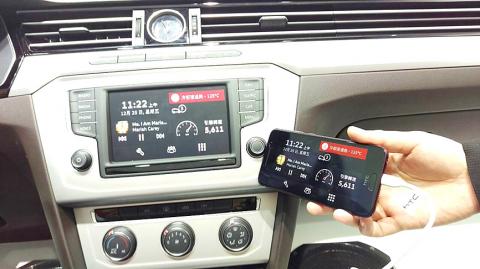HTC Corp (宏達電) yesterday unveiled a vehicle performance measurement solution created in collaboration with German automaker Volkswagen AG (VW) in a bid to enter the fast-growing Internet of Vehicles (IoV) market.
IoV refers to dynamic mobile communications systems that allow communications between vehicles; vehicles and roads; vehicles and people; and vehicles and sensors.
The Taiwanese smartphone maker has been attempting to expand its reach in the IoV market in recent years.

Photo: CNA
In 2011, HTC partnered with Luxgen Motor Co (納智捷), a automobile brand operated by Yulon Motor Co (裕隆汽車), to allow people access to HTC’s entertainment system in their vehicles.
The latest partnership with Volkswagen comes after the company on Monday last week said that it is looking to work with automaker Audi AG to provide its Vive virtual reality (VR) headsets to potential customers so that they can virtually test-drive a vehicle.
Under the partnership with Volkswagen, HTC said a “Customer-Link” app and “Customer-Link Bridge” platform have been launched to allow drivers to gain access to up-to-the-minute information on road and traffic conditions.
The Customer-Link Bridge is a vehicle performance measurement device, while the Customer-Link app provides local traffic information and instant vehicle data to improve security and efficiency while driving, HTC said.
The Customer-Link app can be used in all models of Volkswagen vehicles sold in Taiwan and the Customer-Link Bridge is to be preinstalled in all new vehicles VW sells from May next year, the company said.
Volkswagen said the data will be integrated, appearing simultaneously on the smartphone and auto display of drivers.
“IoV solutions enable owners to be easily connected to their cars and enjoy Volkswagen customer services,” Volkswagen Taiwan managing director Bernd Hoffmann said in a statement.
HTC’s IoV solutions are to be showcased at the Taipei International Auto Show, which is to begin today and run through Sunday next week at the Taipei World Trade Center’s Exhibition Hall 1 and Nangang Exhibition Hall.

To many, Tatu City on the outskirts of Nairobi looks like a success. The first city entirely built by a private company to be operational in east Africa, with about 25,000 people living and working there, it accounts for about two-thirds of all foreign investment in Kenya. Its low-tax status has attracted more than 100 businesses including Heineken, coffee brand Dormans, and the biggest call-center and cold-chain transport firms in the region. However, to some local politicians, Tatu City has looked more like a target for extortion. A parade of governors have demanded land worth millions of dollars in exchange

Hong Kong authorities ramped up sales of the local dollar as the greenback’s slide threatened the foreign-exchange peg. The Hong Kong Monetary Authority (HKMA) sold a record HK$60.5 billion (US$7.8 billion) of the city’s currency, according to an alert sent on its Bloomberg page yesterday in Asia, after it tested the upper end of its trading band. That added to the HK$56.1 billion of sales versus the greenback since Friday. The rapid intervention signals efforts from the city’s authorities to limit the local currency’s moves within its HK$7.75 to HK$7.85 per US dollar trading band. Heavy sales of the local dollar by

Taiwan Semiconductor Manufacturing Co’s (TSMC, 台積電) revenue jumped 48 percent last month, underscoring how electronics firms scrambled to acquire essential components before global tariffs took effect. The main chipmaker for Apple Inc and Nvidia Corp reported monthly sales of NT$349.6 billion (US$11.6 billion). That compares with the average analysts’ estimate for a 38 percent rise in second-quarter revenue. US President Donald Trump’s trade war is prompting economists to retool GDP forecasts worldwide, casting doubt over the outlook for everything from iPhone demand to computing and datacenter construction. However, TSMC — a barometer for global tech spending given its central role in the

The Financial Supervisory Commission (FSC) yesterday met with some of the nation’s largest insurance companies as a skyrocketing New Taiwan dollar piles pressure on their hundreds of billions of dollars in US bond investments. The commission has asked some life insurance firms, among the biggest Asian holders of US debt, to discuss how the rapidly strengthening NT dollar has impacted their operations, people familiar with the matter said. The meeting took place as the NT dollar jumped as much as 5 percent yesterday, its biggest intraday gain in more than three decades. The local currency surged as exporters rushed to